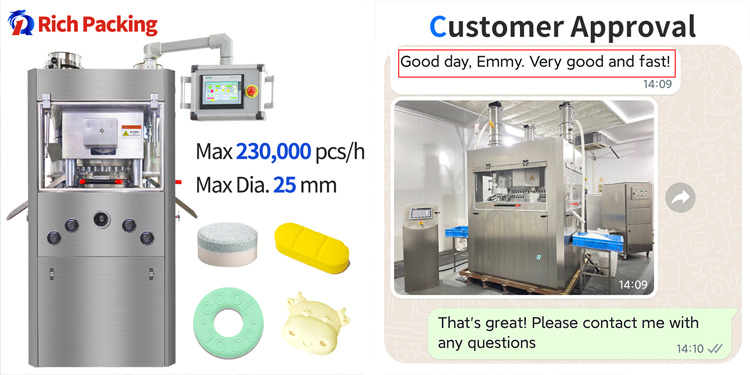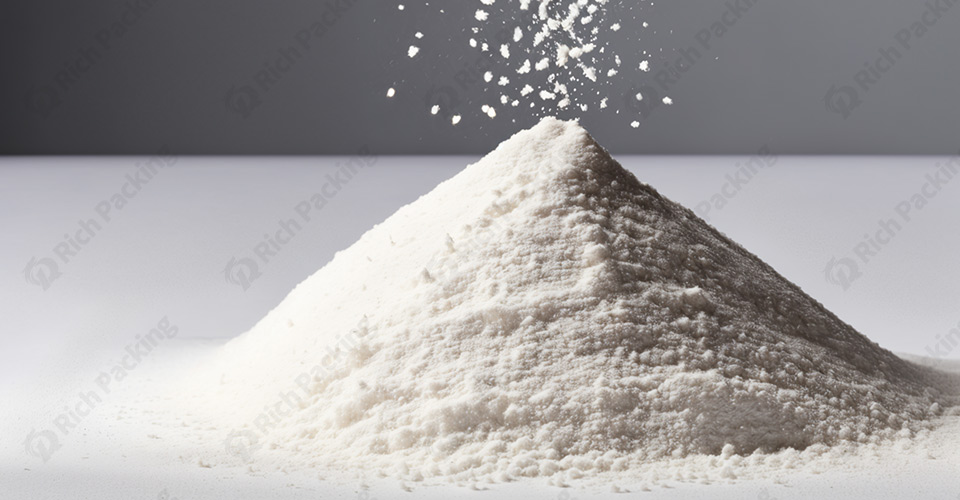Categories
New Blog
Tags
In the pharmaceutical and related industries, tablet presses are one of the core equipment. The precise control of tablet weight is directly related to product quality and production efficiency. In this paper, we will discuss the factors affecting the weight of tablets and effective control methods to help the industry to improve the production level.

Tablet press machine are widely used in pharmaceutical, food and other industries for pressing various granular raw materials into tablet products. In the pharmaceutical field, the quality of tablets directly affects the efficacy and safety of drugs. Accurate control of tablet weight ensures that the dosage of active ingredients contained in each tablet is accurate, thus ensuring the stability and reliability of the therapeutic effect of the drug. At the same time, stable tablet weight control can help to improve production efficiency, reduce scrap rate and production cost, which is of great significance to the economic benefits and market competitiveness of enterprises.
The characteristics of particles have a significant impact on the weight of tablets.
Coarse and fine distribution of particles: when pressing tablets, if the coarse and fine distribution of particles is not uniform, it will lead to different flow rates of particles. If there are more coarse particles, the tablets will be lighter, and if there are more fine particles, the tablets will be heavier, because the thickness of the particles filled into the holes of the center mold is not uniform, which directly affects the weight of the tablets. According to studies, uneven distribution of particles may result in sheet weight differences of more than 20% of the specified limit.
Flowability: Poor particle flow can cause the amount of particles flowing into the mold hole to be unstable, resulting in large variations in piece weight. For example, when particle flow is poor, some mold holes may be overfilled with particles while others are underfilled.
Delamination: Delamination occurs between particles due to differences in density, particle size and other properties, and the distribution of particles in each layer is not uniform when pressing tablets, resulting in unstable tablet weight. This delamination phenomenon is more common in some multi-component particle systems.
Humidity and Viscosity: Particles with excessive humidity or viscosity are prone to adhere to the equipment during the tabletting process, affecting the weight of the tablets. For example, when produced in an environment with high humidity, the particles may absorb moisture and become sticky, which not only affects the filling volume, but also may lead to equipment clogging.

The condition of the equipment is directly related to the accuracy of the piece weight.
Punch and die-hole fit: More powder leakage between the periphery of the punch and the die-hole wall will cause underfilling of the material, thus affecting the weight of the tablets. A poor fit can result in a variance of up to 30% in tablet weight.
Clogging of the hopper: Sticky or humidity-inducing drugs tend to clog the hopper, affecting the continuous supply of granules and thus causing differences in tablet weight. Statistically, clogged hoppers can increase scrap rates by up to 25%.
Wear and tear of equipment: Wear and tear of punches, filling rails, etc. can lead to unstable flake weight. As the equipment is used, the wear will gradually increase, and the flake weight deviation will become larger and larger.
Improper equipment setup: A rotary table that is too fast, or pressure that is not set correctly, can also affect sheet weight. For example, when the rotary table speed is too fast, the particles are not filled sufficiently, which will easily lead to the light weight of tablets.
Improper behavior during operation can have a negative impact on flake weight.
Uneven dosing: When manually dosing tablets, improper operation may lead to uneven dosing. This can result in large differences in the weight of different tablets, affecting product quality.
Incomplete cleaning: Incomplete cleaning of the equipment and residues can affect the subsequent pressing of tablets, resulting in unstable tablet weight. Residues may mix with newly added granules and change the nature of the granules, thus affecting the tablet weight.
Pressure is one of the most important factors affecting tablet weight. If it is necessary to increase the flake weight, the pressure can be increased appropriately. For example, the pressure can be increased by changing the setting of the pressure regulating valve. Experience has shown that proper adjustment of the pressure regulator can increase the weight of the sheet by approximately 10% to 15%. In addition, replacing the pressure shims with higher pressure shims is also an effective way to do this. However, when adjusting the pressure, it is necessary to operate carefully to avoid excessive pressure leading to tablets that are too hard, which will affect the patient's taking experience and may even cause damage to the equipment.
The feed quantity has a significant effect on the tablet weight. To increase the tablet weight, the feed volume can be increased appropriately. This can be achieved by adjusting the rotation speed of the feed wheel or tray. As the speed of the feed wheel is increased, the amount of feed is increased and the piece weight rises. In general, for every 10% increase in feed wheel speed, the piece weight may increase by approximately 5%. Also, adjusting the position of the feed mechanism can change the feed volume. For example, adjusting the feed mechanism closer to the mold can increase the rate and amount of particles flowing into the mold, thereby increasing the flake weight. However, the feed volume should not be increased excessively, as this may result in insufficient pressure and affect the quality of the tablets.
The gap between the press wheel and the mold of the tablet press affects the thickness and weight of the tablets. The smaller the gap, the thinner the tablet thickness; the larger the gap, the thicker the tablet thickness. By adjusting the gap between the press wheel and the mold, the thickness and weight of the sheet can be effectively adjusted. In practice, if the gap is reduced by 1 mm, the thickness of the sheet may be reduced by about 0.5 mm, and the corresponding sheet weight will also be reduced. However, when adjusting the gap, it should be adjusted according to the specific material properties, equipment parameters and process requirements. It is recommended to conduct a small trial or test before adjustment to find the optimal settings for sheet thickness and sheet weight.
Ensure uniform particle thickness distribution by improving the granulation process. For example, the use of advanced spray drying technology can make the particle size more consistent, according to experimental data show that the uniformity of particle thickness distribution can be increased by more than 30% after the use of this technology.
Improve particle fluidity, add appropriate flow aids, such as micronized silica gel, to improve particle fluidity. Generally speaking, adding the right amount of micronized silica gel can improve the flowability of particles by about 20%.
control particle humidity and viscosity, according to the nature of the drug to adjust the humidity and viscosity control parameters in the granulation process. For example, for some drugs which are easy to absorb moisture, the relative humidity can be controlled below 40% in the granulation process to reduce the viscosity of the granules.
Regularly check and replace worn parts, such as punches, die holes, filling rails, etc., to ensure that the equipment is in good condition.
Adjust the parameters of the equipment, according to the nature of the drug and production demand, set the rotary table speed, pressure and other parameters reasonably. For example, for viscous drugs, the rotary table speed can be appropriately reduced to ensure that the particles are fully filled.
Keep the equipment clean, clean the equipment regularly to avoid the influence of residue on the quality of pressed tablets. The remaining powder should be taken out after each day's use, and the various parts of the machine should be wiped clean. If the stopping time is longer, the punching mold should be removed, and the various friction surfaces and working surfaces of the machine should be wiped clean, coated with rust-proof oil, and covered with dust-proof clothes.
standardize the dosing operation, adopt automatic dosing system or train operators to ensure even dosing. Automatic dosing system can precisely control the dosing amount and reduce the influence of human factor on the weight of the tablets, according to the statistics, the use of automatic dosing system can reduce the difference of the weight of the tablets by more than 15%.
establishes a quality control system and sets up quality control points in the production process to find and solve problems in time. For example, samples can be taken regularly for sheet weight testing, and production parameters can be adjusted as soon as excess sheet weight is found.
introduces an online inspection system to monitor the sheet weight difference in real time and adjust the production parameters in time. The on-line inspection system can quickly and accurately detect the slice weight, and once abnormalities are found, it can send out alarms in time, so that operators can make timely adjustments.
applies intelligent control system to realize automation and precise control of the production process through the intelligent control system. Intelligent control system can automatically adjust the running state of the equipment according to the preset parameters, which greatly improves the production efficiency and the stability of tablet weight.
Tablet press weight control is a complex process involving many factors. From particle characteristics to equipment condition to operation standard, each link has an important influence on the tablet weight. By reasonably adjusting the parameters such as pressure, feed volume, press gap, etc., as well as adopting comprehensive control strategies and strict quality management system, the precision and stability of tablet weight control can be effectively improved. This not only helps to ensure product quality and improve the production efficiency of enterprises, but also provides a solid guarantee for the development of pharmaceutical and other industries to ensure the provision of safe and effective products for consumers.